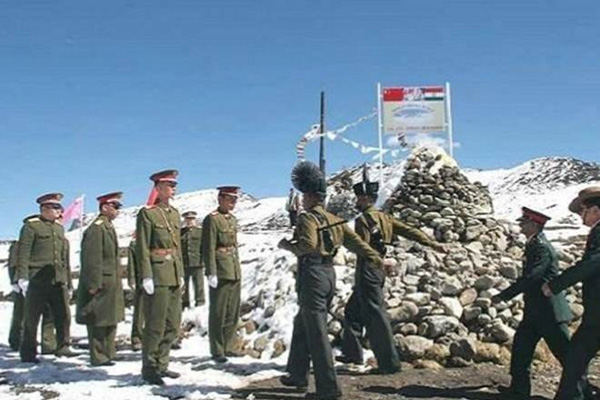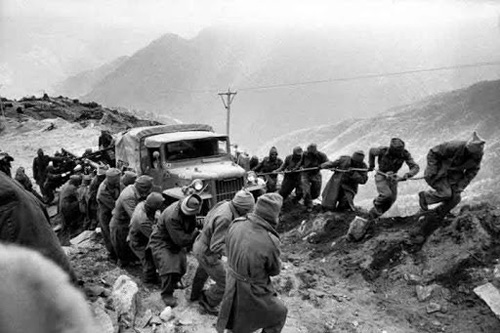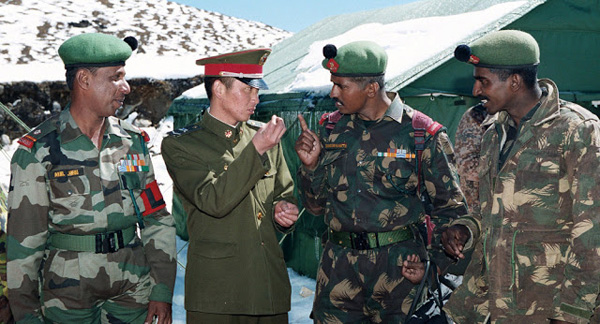India China Relations A Perspective History Essay - Part 2
By Philip Mudartha
Bellevision Media Network
India China Relations A Perspective History Essay - Part 2
A brief on 1962 Sino-Indian War:
In part-1 of this essay, we have dealt with the prelude to this war. Here, we deal with the actual war in which our military suffered a humiliating defeat at the hands of PLA in both theatres. In the western theatre of Aksai Chin in Eastern Ladakh, the PLA advanced to their 1960 Claim Line on the Ladakh Ranges. In the eastern theatre of India-Sikkim-Bhutan-NEFA Himalayan passes, the PLA trounced all our forward formations and captured the entire NEFA. Their offensive began on 20th October 1962 and ended on 20th November, a month of hostilities, when they declared a unilateral cease-fire. In western theatre, they kept the new territory captured while in eastern theatre they vacated NEFA and returned behind the McMohan Line. As a result of the war, the entire border between the two nations was militarized. The distrust that the war caused casts its shadow on our mutual relationship even after 58 years.
I base this section of the essay on the Henderson Bhagat Enquiry Report which the government commissioned to analyse the causes of our military debacle. Lt. General Henderson Brooks and Brigadier General Premindra Singh Bhagat were two senior military officers at the time. Their report is a top secret classified document. Successive governments, including the BJP-NDA which has ruled for 11 years since 1998, have neither declassified it nor tabled it in parliament. Yet, a copy of it was leaked to an Australian journalist, who has attached it to his blog. I recommend that readers download and study it to understand the war in greater detail.
Let me begin with Indian perspective on relations with PRC:
?PLA invaded Tibet and occupied it 1950. The 14th Dalai Lama-led Tibetan government signed an agreement with PRC accepting Chinese Sovereignty. This 17-point peace declaration of 1951 guaranteed ‘autonomy” to Tibetan government. Nehru played a constructive role in encouraging and guiding the young Dalai Lama to sign this agreement. Nehru was very clear about his Tibet policy: Tibetans would enjoy total autonomy in governing themselves under the sovereignty of PRC. India would continue to pursue its century-old privileges in Tibet in exchange for accepting that Tibet is a part of China.
?India signed the Panch-sheel Agreement with PRC in 1954 which required both nations not to interfere in international affairs of the other and respect the territorial integrity and sovereignty of each other. Indian establishment both political and military interpreted that PRC will never invade Indian territory as defined by the treaties signed between British India, princely state of J&K, and Tibet.
?During the Korean Civil War (1950-53), PLA joined forces with communist forces of the north, fighting against Republic of Korea (ROC) supported by the US/UN forces. India took on the humanitarian role, providing medical aid & relief to the wounded of both sides, in line with its neutral & on-aligned role. Yet, India appealed for the PRC be included in the Security Council, voting with Soviet Union. From Indian view, India was a great Asian power with global moral authority and PRC would be grateful.
?India was clear about the borders with Tibet, Nepal, Sikkim, Bhutan, and Burma, which were established by British India. There were definite maps drawn up based on the highest peaks of Himalayan ridges and watershed principle was explained. If the water flows south, the territory is Indian and if it flows north, the territory is Tibetan. India, under directions from Nehru, updated the maps showing the McMohan line as its border with Tibet/PRC. PRC did not dispute this till 1956. When it revised its version of the maps in 1958 showing vast tracts of Indian lands within China, Nehru protested to Chou En Lai, the PM of PRC. Chou blamed the inclusions on clerical errors and said that the maps held no meaning.
?In 1957, India discovered Chinese presence in Aksai Chin where the PLA had built an all-weather paved road linking the Xinjiang with Tibet over a period of seven years. At this time, PRC placed the entire Aksai Chin north and east of Ladakh Ridges in its maps. It is through this road, the PLA forces entered Tibet to put down the Tibetan Rebellion of 1959. The PLA began “border control & management” along their new 1960 claim line based on actual possession. India maintained that China has occupied Indian territory. This meant PRC unilaterally abrogated Panch-sheel Agreement.
?After the 1959 Tibetan Rebellion, PLA moved towards south and west in Aksai Chin, occupying more Indian territory.
?Beginning 1958 until 1962, PLA kept encircling newly established Indian military posts in both western and eastern theatres. On 20th October 1962, PLA forces invaded and seized Indian territory in both western and eastern theatres.
?PRC was ungrateful for India had accorded the most diplomatic support during all its conflicts with USA in Korea and Laos. India has played a constructive role in handing the Tibetan Crisis and prevented the Dalai Lama’s drive for declaring independence from China. India believed PRC will not attack India in order to preserve Indian friendship.
Let us examine Chinese perspective:

India pretends to be leader of the Third Block, known as Non-Aligned Movement (NAM). India is very much in the league of imperialists and is hypocrite. It is manipulating the Soviet Union to get advanced military equipment even as getting food & economic aid from the US.
India is in league with the Americans, allowing CIA stations on its soil and participating in subversive activities inside Tibet. The 1959 Tibetan Rebellion is the handiwork of India in league with the US. Thus, India has unilaterally broken the letter and spirit of Panch-sheel Agreement.
Aksai Chin was historically a part of Xinjiang, an autonomous region under Chinese sovereignty for centuries. PRC does not recognise as legal the ascension treaty signed by J&K prince with India and hence India’s claim to Ladakh has no legitimacy. India is an occupation force in J&K including South Xinjiang (Eastern Ladakh).
India gave political asylum to 14th Dalai Lama and hosted his government-in-exile on its territory. This is a hostile act against PRC, aimed at encouraging secessionist forces in Tibet and undermining Chinese sovereignty and territorial integrity.
India advanced into Chinese territory of southern Xinjiang and southern Tibet (NEFA, now Arunachal Pradesh). It set up military posts and deployed forces on Chinese -held and patrolled border lands under its “ill-advised forward policy” beginning in 1959. This shows intent of taking & occupying Chinese territory by military force. India’s expansionist motive is clear. PRC will meet force with force to drive out intruding Indian Army from south Xinjiang and south Tibet.
The Indian military movement north and east is to encircle PLA forces in Tibet and force its retreat. This is evidence that Nehru suffers from a “dark mentality”. He is by nature an imperialist, expansionist, and influenced by his bourgeoisie colleagues. Nehru wants to “grab Tibet and turn it into a protectorate of India”. He is with the “splitters”.
India occupies 90,000 square Kilometres (SKm) and 2,000 SKm of Chinese territory in Eastern sector and middle sector at our frontiers. It seeks to occupy 33.000 SKm in the western sector, which it has never administered anytime in the past. PRC is committed to a peaceful settlement in accordance with Panch-sheel Agreement and the Bandung Declaration (Of NAM Conference chaired by Nehru). But Nehru would not sit down and talk. Nehru does not believe PRC is “new China” and it has “stood up”; it does not “fear the neo-imperialists like Nehru and his upper-class colleagues”.
Analysis of domestic compulsions & International scenarios:
PRC was a starving nation under the quixotic rule of Great Helmsman Chairman Mao Zedong when he undertook the Great Leap Forward in early 1958. During his man-made famine, rivals challenged his authority and he was “almost” ousted from power. To re-capture centre-stage, he needed to energise his base of core Maoists and purge the “counter-revolutionaries”. What best way than to invade India? In any case, he was envious of Nehru’s global stature and dismay at his own “international pariah” status. He loathed Nehru so much that he wanted to “show him his place”. Thus, the reasons for the 1962 Sino-Indian War lay in the “insecure mentality” of Mao.
Mao suspected that the Taipei based nationalist Republic of China (ROC) led by Chiang Kai-shek, in collusion with US and Japan, would mount an attack on mainland PRC. He further suspected that India is encouraged by PLA’s predicament of protecting PRC from ROC’s designs and evaluated that PLA is not in an advantageous position to start a war with India. In other words, India assumed that PRC will not defend the territory in its control as on 7th November 1959. That date is when India put in place its “forward policy” and began setting up military posts behind the PLA positions in both eastern and western sectors.
Russian leader Nikita Khrushchev praised Nehru in a 1959 meeting with Mao. Sino-Russian relations were not good, and this meeting resulted in their famous split. Mao resented this fact and held personal grievances against Nehru. His resolve to humiliate Nehru and dethrone him from the Third World leadership got stronger.
Nehru had two successful state visits to the US, where President Eisenhower in 1960 and President JF Kennedy in 1962, hosted him with warmth. These friendships with Kennedy and Khrushchev instilled in Nehru a false confidence that both superpowers will side with India in any border conflict with PRC. However, he did not consider that JFK and Khrushchev were involved eyeball-to-eyeball in The Cuban Crisis and for them Indian security was not as strategic as Nehru thought.
Chou En Lei visited Delhi in April 1960 with his defence minister, a decorated military commander. In his meetings with Nehru, he offered to swap the NEFA territory with Aksai Chin territory held by PLA. For Chou, it meant accepting the McMohan line as legitimate. Nehru did not budge from his condition that PLA must vacate all “Indian territory” in Aksai Chin before any negotiations. At his advice, Chou met various cabinet colleagues of Nehru including Morarji Desai, G.B. Pant, VK Krishna Menon and Vice-President Radhakrishnan. Morarji treated him with tactless disdain, Radhakrishnan was preachy, Menon viewed that the only border problem was occupation by PLA of Indian territory, and Pant exhibited “stark class attitude”. He flew back to report to Mao that “Indian government is not interested to peacefully settle the border problem.” This is what Mao was waiting to hear. Nehru wanted a fight with him, and he will not disappoint Nehru.”
The wound inflicted on Indian psyche:
China achieved its political aim in inflicting a heavy defeat on India, causing Indian leadership “to fear the New China”. The Indian population came to loathe the Chinese and continue to distrust any friendly overtures from that “back-stabbing” nation. The Henderson Bhagat enquiry report establishes that our government’s “forward policy was militarily unsound because PLA strength was about six times that of Indian military”. It blames the military leadership, especially Chief Of general Staff, General B.M. Kaul of aggressively advocating and implementing the policy on the frontiers knowing fully well that he did not have the resources to challenge PLA. That the Indian army’s military ingress to encircle PLA position on Tagla Ridge, several miles north of McMohan Line on 9th October 1962 precipitated the “severest onslaught of PLA” to “kill, exterminate and punish Indian soldiers”. They only stopped when they reached the foothills of Himalayas overlooking Brahmaputra River Valley. Then, they withdrew north of McMohan Line, claiming to have acted in “self-defence”. Indians, to date, have not forgiven China for this treachery.
The setback to the Non-Aligned Movement (NAM) that Nehru championed.
Military power is what begets power is what Mao believed and proved to the newly independent nations of Asia and Afrika. A 32 page letter from Chou En Lei with dozens of attachments despatched on 15th November documenting the “diplomatic efforts of PRC to settle the border dispute with India in the same manner as it did with Burma and Nepal” is proof that for PRC, India was a minor nation in Asia. With the Indian defeat, PRC seized the leadership of the Third World, demolishing the Nehruvian doctrine that “non-violent moral authority being superior to military strength”.
Why we should not judge Nehru harshly

Mao Zedong by his vitriolic rhetoric and personal attacks on Nehru in the CCP controlled state media since Nehru’s 70th birthday, 19th November 1959, provoked national outrage in India against China and its leadership. Nehru’s hand of friendship was misunderstood as weakness, so our media and Nehru’s opposition both in Parliament and in his own Congress party said. The progressive and saner voicer in India were discredited. Particularly stinging for Nehru was that his Tibetan policy was guided by his “idealism and naivete”. In fact, Nehru’s Tibetan policy was pragmatic since India could not take on PRC militarily. His diplomacy was aimed at securing Tibetan autonomy (as set forth in 1951 Sino-Tibetan agreement) while acknowledging the historic fact that China had sovereignty of Tibet. By militarising Tibet, PRC broke its part of the agreement by 1959, forcing Nehru to take a hard line against PRC. Thus, due to domestic political compulsions, Nehru abandoned the “friendship with China” in favour of forward policy, which was sheer brinkmanship.
Nehru erred not in his friendship policy but in its reversal after November 1959 pushed to the wall by the right-wing opposition to his “Tibetan philosophy”. Outgoing Chief of Army Staff (CAS) Gen Timmayya had recommended Gen Thorat to be appointed as his successor. Nehru erred in going by seniority and appointed gen tap erred in not taking Gen Tapar, who entrusted Gen BM Kaul as his Chief of General Staff (CGS). Going by Henderson Bhagat report and by the book “the Himalayan Blunder” authored by Brigadier John Dalvi, poor planning, and leadership of Gen Kaul is to blame for the Himalayan shame. Dalvi was Kaul’s man-on-the ground assigned with the task of “throwing Chinese out of our territory in eastern theatre” but who had advised Kaul against the misadventure of crossing the McMohan line and surrounding the PLA in Tagla Ridge.
Henderson Bhagat report establishes the clear directions issued by Nehru government, leaving operational planning to the CAS and CGS. It puts the blame more on the CGS, in failing to advise the political leadership of the unsoundness of continuing the forward policy even after meeting resistance from PLA, especially the Kong La skirmishes.
The shift in Indian assessment of PRC’s true intentions
The defeat caused a reassessment of PRC’s true intentions. India debunked its belief that PRC will not counterattack even if it is able to do so. As said in the “Art of War”, military planning should not depend on enemy intent of coming; it should depend on its military capabilities. The Nehru government prioritized national integration, economic development and building democratic institutions over national security vis-à-vis a major military power on its northern borders. This doctrine had to go in favour of military strength.
The embrace of Soviet Union while paying lip service to NAM under Nehru’s successors.
The cost of the 1962 Sino-Indian War to PRC was strategic. By its action, PRC pushed India closer to Soviet Union. India remained a Non-Aligned Nation only in name, while hugging Soviet Union as its “all-weather ally”. Under Nehru’s daughter, PM Indira Gandhi, India signed the 25-year co-operation agreement with Soviet Union, thus effectively providing for a nuclear umbrella against Chinese designs on India. That India could assimilate Sikkim as a state, it could convert NEFA into Arunachal Pradesh and could wage the 1971 War for “Bangladesh Liberation”. The Siachen Glacier military conquest of 1984 also saw no PLA reaction. By 1998, India gave up its secrecy about nuclear capability and went ahead with closer ties with the USA as well. At the time of writing in 2020, it is nearly two decades since “strategic relationship” with the USA blossomed while maintaining the warmth in relations with Russian Federation.
The 1967 victory in border clashes with PRC

The Nathu La clashes started on 11th September 1967, when the PLA launched an attack on Indian posts at Nathu La in eastern theatre. It lasted till 15th September. In October 1967, another military duel took place at Cho La, and ended on the same day. The clashes eventually left 88 Indian soldiers dead. More than 300 PLA soldiers were killed.
Having sent its message militarily, India, on September 12, delivered a note to the Chinese, offering an unconditional ceasefire across the Sikkim-Tibet border beginning 5.30 am on September 13. This was rejected, but the situation remained largely peaceful until the 14th. On September 15, the Chinese handed over the bodies of Indian soldiers with arms and ammunition, saying they were acting in the interest of “preserving Sino-Indian friendship”.
This is the last major skirmish between Indian Armed Forces and PLA until the latest on 15th June 2020 in Galvan River Valley in Eastern Ladakh.
I suggest that those readers want to study the subject, read scholarly articles available on Google Books, particularly the Himalayan Blunder by Brigadier John Dalvi.
(concluded)
India China Relations A Perspective History Essay - Part 1
 Write Comment |
Write Comment |  E-Mail To a Friend |
E-Mail To a Friend |
 Facebook |
Facebook |
 Twitter |
Twitter |
 Print
Print 


















